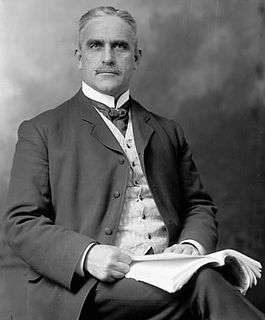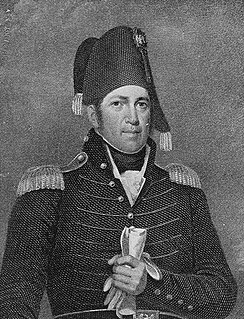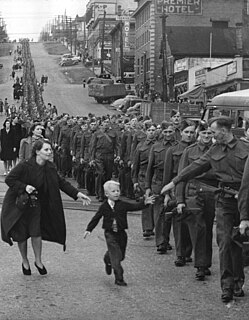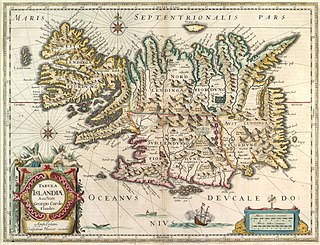
Major-General Sir Isaac Brock KB was a British Army officer and colonial administrator from Guernsey. Brock was assigned to Lower Canada in 1802. Despite facing desertions and near-mutinies, he commanded his regiment in Upper Canada successfully for many years. He was promoted to major general, and became responsible for defending Upper Canada against the United States. While many in Canada and Britain believed war could be averted, Brock began to ready the army and militia for what was to come. When the War of 1812 broke out, the populace was prepared, and quick victories at Fort Mackinac and Detroit defeated American invasion efforts.
The colonial militias in Canada were made up of various militias prior to Confederation in 1867. During the period of New France and Acadia, Newfoundland, and Nova Scotia (1605-1763), these militias were made up of Canadiens, First Nations, British and Acadians. Traditionally, the Canadian Militia was the name used for the local sedentary militia regiments throughout the Canadas.
The Battle of York was a War of 1812 battle fought in York, Upper Canada on April 27, 1813. An American force supported by a naval flotilla landed on the lakeshore to the west and advanced against the town, which was defended by an outnumbered force of regulars, militia, and Ojibway natives under the overall command of Major General Roger Hale Sheaffe, the Lieutenant Governor of Upper Canada.

Sir Samuel Hughes, was the Canadian Minister of Militia and Defence during World War I. He was notable for being the last Liberal-Conservative cabinet minister, until he was dismissed from his cabinet post.

War Plan Red, also known as the Atlantic Strategic War Plan, was one of the color-coded war plans created by the United States Department of War during the interwar period of 1919–1939, covering scenarios related to a hypothetical war with the British Empire. Many different war plans were prepared by mid-level officers primarily as training exercises in how to calculate the logistical and manpower requirements of fighting a war, and War Plan Red outlined those steps necessary to defend against any attempted invasion of the United States from British forces. It further discussed fighting a two-front war with both Japan and Great Britain simultaneously.

The Fenian raids were carried out by the Fenian Brotherhood, an Irish Republican organization based in the United States, on British Army forts, customs posts and other targets in Canada, in 1866, and again from 1870 to 1871. A number of separate incursions by the Fenian Brotherhood into Canada were undertaken to bring pressure on Great Britain to withdraw from Ireland, although none of these raids achieved their aims.

Jacob Jennings Brown was known for his victories as an American army officer in the War of 1812, where he reached the rank of general. His successes on the northern border during that war made him a national hero, and he was awarded a Congressional Gold Medal.
The Raid on Gananoque was an action conducted by the United States Army on 21 September 1812 against Gananoque, Upper Canada during the War of 1812. The Americans sought to plunder ammunition and stores to resupply their own forces. Gananoque was a key point in the supply chain between Montreal and Kingston, the main base of the Provincial Marine on the Great Lakes. Under the command of Captain Benjamin Forsyth, the Americans departed Ogdensburg, New York and sailed to Gananoque, where they encountered resistance from the 2nd Regiment of Leeds Militia. The British militia was forced to retreat and the Americans successfully destroyed the storehouse and returned to the United States with captured supplies. As a result of the raid, the British strengthened their defences along the St. Lawrence River.
The Iraq War began with the US-led 2003 invasion of Iraq. The Government of Canada did not at any time formally declare war against Iraq, and the level and nature of this participation, which changed over time, was controversial. Canada's intelligence services repeatedly assessed that Iraq did not have an active WMD program.

The history of Canada during World War II begins with the German invasion of Poland on 1 September 1939. While the Canadian Armed Forces were eventually active in nearly every theatre of war, most combat was centred in Italy, Northwestern Europe, and the North Atlantic. In all, some 1.1 million Canadians served in the Canadian Army, Royal Canadian Navy, Royal Canadian Air Force, and in forces across the empire, with approximately 42,000 killed and another 55,000 wounded. During the war, Canada was subject to direct attack in the Battle of the St. Lawrence, and in the shelling of a lighthouse at Estevan Point in British Columbia.

In early 1942 elements of the Imperial Japanese Navy (IJN) proposed an invasion of mainland Australia. This proposal was opposed by the Imperial Japanese Army and Prime Minister Hideki Tojo, who regarded it as being unfeasible given Australia's geography and the strength of the Allied defences. Instead, the Japanese military adopted a strategy of isolating mainland Australia from the United States by advancing through the South Pacific. This offensive was abandoned following the Battle of the Coral Sea and Battle of Midway in May and June 1942, and all subsequent Japanese operations in the vicinity of Australia were undertaken to slow the advance of Allied forces.

Brigadier General James "Buster" Sutherland Brown was a Canadian military officer best known for drafting a contingency war plan in 1921 to invade and occupy several American border cities. The style of the plan was Defence Scheme No. 1. What is much less well known are Brown's substantial contributions in the area of planning and logistics during his service as a senior staff officer in the Canadian Expeditionary Force (CEF) on the Western Front during the First World War.
The results of the War of 1812, which was fought between the United Kingdom and the United States from 1812 to 1814, included no immediate boundary changes. The main result of the War of 1812 has been two centuries of peace between both countries.

During the World Wars and Interwar Years,1914–1947, Canada experienced economic gain, more freedom for women, and new technological advancements. There were severe political tensions over issues of war and ethnicity, and heavy military casualties. The Great Depression hit Canada hard, especially in export-oriented mining and farming communities, and in urban factory districts.

The 61st Infantry Division was an infantry division of the British Army, raised in 1939 as part of the expansion of the Territorial Army in response to the German occupation of Czechoslovakia. The division was created as a duplicate of the 48th Infantry Division, and was assigned to home defence duties.

The Allied occupation of Iceland during World War II began with a British invasion intent on occupying and denying Iceland to Germany. The military operation, codenamed Operation Fork, was conducted by the Royal Navy and Royal Marines. In time, some of the British garrison was replaced by Canadian and later American forces, despite the fact that the United States was not yet in the war.

At the beginning of World War II, Iceland was a sovereign kingdom in personal union with Denmark, with King Christian X as head of state. Iceland officially remained neutral throughout World War II. However, the British invaded Iceland on 10 May 1940. On 7 July 1941, the defence of Iceland was transferred from Britain to the United States, which was still a neutral country until five months later. On 17 June 1944, Iceland dissolved its union with Denmark and the Danish monarchy and declared itself a republic, which remains to this day.

The Patriot War was a conflict along the Canada–United States border where bands of raiders attacked the British colony of Upper Canada more than a dozen times between December 1837 and December 1838. This so-called war was not a conflict between nations; it was a war of ideas fought by like-minded people against British forces.
Defence Scheme No. 2 was a Canadian military strategy developed after the First World War that outlined the Canadian response in the event of a war between the United States and Japan. The primary concern of the strategy was remaining neutral in any conflict between the two countries.

The concept of an invasion of the United States relates to military theory and doctrine which address the feasibility and practicality of a foreign power attacking and successfully invading the United States. The country has been physically invaded a few times – once during the War of 1812, once during the Mexican–American War, several times during the Mexican Border War, and twice during World War II. During the Cold War, most of the US military strategy was geared towards repelling an attack by the Soviet Union.













